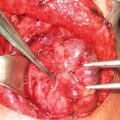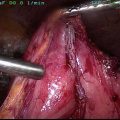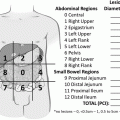Avoidance of Axillary Lymph Node Dissection Patient Selection Guidelines(ACOSOG Z0011)
Tumor size <5 cm (T1 or T2)
Fewer than 3 positive SLN
No evidence of extracapsular tumor extension in SLN
Planned whole breast radiation therapy
Planned standard of care adjuvant therapy
Published results from the AMAROS trial are eagerly awaited. Results were presented at the 2013 ASCO meeting and demonstrated that for women with tumors less than 3 cm and a positive sentinel lymph node that there was no difference in local recurrence or overall survival between the surgical arm (completion node dissection) and the radiation arm (regional nodal field). Notably, lymphedema rates were twice as high in the surgical arm [27]. The group therefore recommend against completion node dissection for this select group of patients.
The use of sentinel lymph node biopsy in the setting of neoadjuvant chemotherapy for the node-positive patient has also been studied. Researchers have attempted to clarify if sentinel lymph node biopsy is an appropriate surrogate to determine down-staging of the axilla following chemotherapy. The ACOSOG Z1071 (Alliance trial) reported a 12 % false-negative rate which exceeded their predetermined threshold of 10 %. Notably, for those patients whose sentinel lymph node was identified with dual tracer technique, a higher yield of nodes were identified and the false-negative rate was not exceeded. Nonetheless, as the primary aim null hypothesis was not negated, the study group does not recommend use of sentinel lymph node biopsy following the neoadjuvant treatment of patients with node-positive breast cancer [28].
Adjuvant Therapy
Breast cancer care has become more personalized and treatment more targeted. A more sophisticated understanding of the biology of the tumor is integral to making well-matched treatment selections. Disagreement exists however on the appropriateness of the tools that are currently available to aid in this effort. As a matter of gold standard, the OncotypeDx assay was quickly received and integrated into standard care. The RT-PCR test which assists in the risk–benefit analysis of adjuvant chemotherapy for women with ER+, node-negative tumors was validated on a prospectively collected data set. As such its application in treatment decision making, to add cytotoxic chemotherapy or not, has not met much disagreement. Its broader utility for patients who are node positive is currently being studied in the cooperative SWOG 0007 trial. Other contemporary assays, such as the Mammaprint microarray assay, have received FDA approval and are enjoying some practice uptake. The MINDACT trial (Micorarray in Node negative and 1–3 positive lymph node disease may avoid chemotherapy) results are eagerly awaited. This prospective, randomized Phase III trial exceeded its target enrollment with 6700 patients. Those patients were assessed concordantly by both microarray and traditional clinic-pathologic measures and placed into high risk or low risk categories. Those at high risk were treated with cytotoxic chemotherapy while those at low risk were given hormonal therapy. Those patients for whom discordance existed between the microarray analysis and traditional pathologic predictors were randomized to receive either chemotherapy or hormonal therapy based on clinic-pathologic risk assessment or Mammaprint. The results of this trial have significant potential to change how we determine adjuvant therapy for a large number of our patients.
Radiation
Radiation therapy has long enjoyed a pivotal role in the management of breast cancer. For well over 20 years now, whole breast radiation has been accepted as a critical and effective tool to reduce local recurrence following breast conserving therapy [14–18]. Similarly, the use of post-mastectomy radiation therapy (PMRT) in the setting of substantial node-positive disease burden (>3 nodes positive) has also been well established [29].
Partial Breast Irradiation
Recognition that the elsewhere in breast failure rate at 5 years equals that of the rate of occurrence in the unaffected breast spurred researches to consider treating what may be considered the area of the breast that can be impacted by radiation therapy. T o this end, early researchers proposed and conducted small trials assessing the safety of partial breast irradiation. No significant difference thus far has been found to exist between the methods of accelerated partial breast irradiation: brachytherapy catheter, indwelling balloon, or 3-D conformal technique. Single institution studies have shown that in well selected patients (T < 3 cm, node-negative, absent lymphovascular invasion, and age >50 years) that local failure rates are comparable to whole breast radiation treatment paradigms [30, 31]. In 2009, the American Society for Radiation Oncology (ASTRO) released a consensus guideline focused on the appropriate patient selection for accelerated partial breast radiation [32]. Other groups have subsequently challenged the lack of concordance between this proposed classification and actual patient outcome data stratified using the consensus criteria [33, 34]. NSABP B-39 was designed so that in a prospective randomized manner, a direct comparison may be made between accelerated partial breast and whole breast techniques for patients not only in low-risk categories, but also for women with stage 0, 1, and 2 breast cancer. Enrollment is complete and follow up data are pending.
Post-Mastectomy Radiation
The use of post-mastectomy radiation therapy has long been established as a means to improve both local control and improve survival for those patients with four or more positive lymph nodes. More recent meta-analyses have revisited its application for those patients with pN1a disease (3 or fewer positive lymph nodes). In summary, a benefit for both local recurrence and survival was attributable to the addition of chest wall and nodal radiation fields irrespective of use of systemic therapy [29]. Critics however note that given the data sets used in these studies, that the systemic therapy at that time is well known to not provide as optimal disease-free and overall survival as compared to more modern regimens. With this in mind, they caution the application of the historic meta-analysis to modern clinical practice [35].
Omission of Radiation Therapy
As our understanding of the risk and benefits to radiation therapy expands, the importance of thoughtful patient selection becomes more paramount. No better example of this exists then for those patients for whom radiation therapy might be avoided. Hughes et al. identified a group of women at low risk for local failure (age >70, T1, ER+ on tamoxifen) for whom there was little clinical benefit to adjuvant radiation therapy [36]. Despite this report in 2004, per review of Medicare data little progress has been made in the appropriate omission of radiation therapy in this well selected patient group [37]. In response to this information, the original cooperative group published updated trial data that demonstrated that the results of CALGB 9343 were durable and remained efficacious even at 12 years of follow up [38].
Other groups have studied the omission of radiation therapy in the setting of favorable cases of DCIS (low and intermediate grade, <2.5 cm mammographic extent) and have concluded that with margins >10 mm, the annual risk of recurrence is 1.9 %, or a 10-year local recurrence rate of 15 % [39]. These authors suggest that this option be candidly discussed as part of the treatment algorithm.
Conclusions
Nearly every aspect of breast cancer diagnosis and treatment has dramatically changed over the past two decades. This has led to improved survival and decreased patient morbidity. In fact much of this progress is attributable to randomized, prospective trials which provide us with Level 1 evidence. Ironically, this very success creates a very high standard for research and thus presents a significant challenge going forward given the current context of personalized care. As we better delineate the details of any one patient’s breast cancer characteristics, their eligibility for any one trial will likely be narrowed. Future progress will be found in smaller, targeted trials with the focus on neoadjuvant period so as to make clinical observations and to draw conclusions in a time period appropriate for contemporary practice.
References
2.
US Preventative Services Task Force. Screening for breast cancer: U.S. Preventive Services Task Force recommendation statement. Ann Intern Med. 2009;151(10):716–26. W-236, doi: 10.7326/0003-4819-151-10-200911170-00008.CrossRef
3.
Bleyer A, Welch HG. Effect of three decades of screening mammography on breast-cancer incidence. N Engl J Med. 2012;367(21):1998–2005. doi:10.1056/NEJMoa1206809.PubMedCrossRef
4.
Miller AB, et al. Twenty five year follow-up for breast cancer incidence and mortality of the Canadian National Breast Screening Study: randomized screening trial. BMJ. 2014;348:g366. doi:10.1136/bmj.g366.PubMedPubMedCentralCrossRef
Stay updated, free articles. Join our Telegram channel

Full access? Get Clinical Tree







